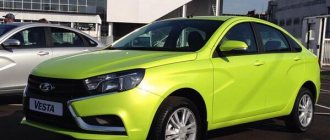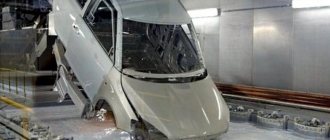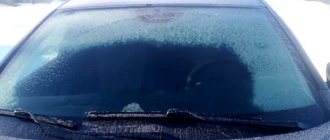Crash test Lada Vesta Starting from the very first stages of designing a new car, its developers calculate the structural strength of the future body and simulate the operation of safety systems. But this is not enough for an accurate assessment. It is necessary to test the model after complete assembly and completion. The Lada Vesta crash test was carried out with a ready-to-use sample.
Passive and active safety
There are such concepts as active and passive machine safety. A number of electrical systems are classified as passive:
- braking devices;
- steering, hydraulic, electric power steering;
- control systems during a skid, when entering a turn;
- exchange rate stability and stabilization system;
- ABS and others.
All these devices are designed to protect the car from getting into an accident.
Active ones include:
- energy-absorbing spars;
- rigidity of load-bearing body elements;
- airbags and curtain airbags;
- belts with pretensioners;
- glass that does not break into fragments and others.
These elements are responsible for preserving people's lives during and after an accident.
RESULTS. IS IT WORTH BUYING A LADA VESTA?
Immediately answering the question: “No, it’s not worth it, unless you have a complete collection of T-shirts with Putin and Crimea is ours at home.”
“What to do if you really want to?”
- “Wait for restyling.”
In addition to eliminating many of the identified shortcomings and those problems that are yet to appear during the operation of thousands of cars in different conditions, it is worth waiting for a higher degree of localization of production, which should have a positive effect on both the price of the new car and its maintenance.
AvtoVAZ President Bo Inge Andersen, when creating the Lada Vesta, adopted the Chinese strategy, with the main emphasis on rich equipment - “more car, for less money.” Unfortunately, it was not possible to avoid the same problems - mistakes and miscalculations, questionable reliability. We also perceived the first Chery, Great Wall, Geely, Brilliance, FAW, LAC, Lifan - it seemed tempting, but unknown, scary.
AvtoVAZ testing
Like any developer, AvtoVAZ was obliged to carry out all the necessary tests of its new model. The sedan was crash tested according to the well-known Euro NCAP method, which has the most stringent requirements. The maximum rating for this test is five stars, which is not so easy to achieve.
The EuroNCAP crash test of the Lada Vesta scored 4 stars, which is a good result for a class B car. The safety of the Lada Vesta largely depends on the generous equipment of the basic version, which already has two front airbags, ABS and ESC systems.
Interesting!
After the high test scores announced by the concern, many motorists asked for a video crash test of the Lada Vesta. But AvtoVAZ did not publish any materials confirming the successful test results.
Auto-reactor
Before the start of sales of the budget car Lada Granta, the AVTOVAZ concern carried out a crash test of the new product. It should be noted that a certification crash test took place in the testing laboratory of the Volzhsky Automobile Plant, on the basis of which the new sedan will be allowed for sale. The certification crash test involves checking according to the outdated UNECE rules No. 94-01, which are no longer used in the developed world. These crash test rules involve a vehicle colliding at a speed of 56 km/h with a deformable obstacle at 40% overlap. Representatives of the car plant say that it makes no sense to check the Lada Granta under the more stringent EURONCAP rules, since this car is intended only for markets where strict vehicle safety requirements do not apply. The Granta was tested in the “Norma” configuration, which is equipped with an airbag for the driver. Judging by the results, the driver has a chance of not being seriously injured in an accident under such conditions. For example, the load according to the HIC injury indicator is 561 units, and the UNECE requirements No. 94-01 assume a limit of 1000 units, which is also the limit of the red zone of the EURONCAP tests. However, it must be remembered that even a slight increase in speed during a collision can cause an increase in this indicator almost exponentially. EURONCAP requirements provide for a reduction in the HIC rating from 650 units. Experts from the Togliatti automaker proudly emphasize that during the crash test, the airbag and restraint systems that AVTOVAZ purchases from Takata-Petri worked flawlessly. In fact, in comparison with the Lada Kalina crash test according to EURONCAP requirements, which were carried out in 2005, the Lada Granta showed its best side, the power structure of the car interior remained unchanged, and the entire force of the impact was absorbed by the power front part. There are also no noticeable kinks on the roof of the car. However, the real safety of the Lada Granta can still be judged after independent tests in accordance with EURONCAP requirements. Lada Granta should replace the classic rear-wheel drive cars Lada 2105 and Lada 2107. The car is based on the Lada Kalina platform, but the design has been slightly modified to reduce cost. The budget new product will be equipped with a 1.6-liter 8-valve engine with a power of 80 and 98 hp. In the middle of next year, a version with an automatic transmission produced by the Japanese company Jatco will appear. Production of the car will begin in October, and the new model will be available to purchase from December 1 of this year. Sales of sedans will begin first, hatchbacks will be available a little later.
The entry was published on 10.10.2011 at 21:18 and posted in the Auto News section, VAZ. You can read comments using the RSS feed. The discussion is closed, but you can send a trackback from your site.
Independent testing of Lada Vesta
After the current situation with crash tests conducted by AvtoVAZ, the famous automobile publication Autoreview decided to conduct its own. With the support of the NAMI Car Testing Center, a Lada Vesta car purchased by the publication was tested. The crash test of Autoreview was carried out according to the ARCAP method, the criteria of which are somewhat different from Euro NCAP.
According to the methodology, the sedan was tested for a frontal impact from an oncoming vehicle; the speeds of both participants at the time of the collision were equal to 55 km/h. In the cabin of the prototype there were dummies with installed numerous sensors that determined the force of the impact. As a result of a frontal collision, the sensor readings did not exceed the required figures, and Lada Vesta scored the maximum 4 stars according to ARCAP. This is the first Russian car to receive such high ratings.
Crash test Lada Vesta station wagon
An insurance crash test for the Lada Vesta was carried out in the passive safety laboratory at the Dmitrovsky test site. The speed is low - 15 km/h. That is, a typical city accident is simulated, when a car hits the one in front. This type of test shows how damaged the car will be in an impact and how much it will cost to restore it.
There is no major devastation visible apart from the external elements: the bumper is being written off, the headlight is broken. After the impact, the door and hood open normally. The radiator grille is normal - no fluids are leaking. The technical center identified all the damage.
The headlight is broken, the cross member has moved towards the engine, and the top mount of the radiator block has broken. But it was thanks to this fastening that the radiators themselves remained intact. Further, the radiator trim guide and honeycomb were damaged. The most important thing: Vesta has a removable transverse load with programmed deformation zones.
Thanks to this, the blow did not go further onto the beam. Repair work from an official Lada dealer will cost an average of 40 thousand rubles, and you will have to spend about 70 thousand rubles on spare parts. The total turnkey amount is 110 thousand rubles, and the waiting time for parts is at least 1 month.
At a regular service station, work will cost 40 thousand rubles, spare parts 20 thousand rubles. As a result, the repair will cost 2 times less than from an official dealer, in total - 60 thousand rubles.
We didn't expect a sensation. After all, SW Cross is, consider, the same “just” Vesta, which, like the new Solaris, has already earned the maximum four stars in our ARCAP rating. Yes, the SW Cross is a little heavier, higher, and has bigger wheels, but the AvtoVAZ specialists, who came at our invitation to the Dmitrovsky test site, radiated calm: “They beat us, we know, there is a reserve. »
For the first time, the object of the next crash test was chosen not by us, but by you, our readers. According to the results of voting on the website autoreview.ru, Vesta SW Cross won with a crushing result of 11,147 votes - this is more than Creta, Kaptur and Camry combined!
We started calling Lada dealers and found a brand new SW Cross “somewhere between Leningrad and Moscow,” or rather in the town of Borovichi, 80 kilometers from the famous Bologoe station. Compared to the regular Luxe version, I had to pay an additional 24 thousand rubles for a rear view camera and a “combine” with a seven-inch touchscreen, which are included in the Luxe Multimedia package. Another 12 thousand for bright orange metallic. Total 792 thousand rubles! You can only console yourself with the fact that now SW Cross has become another 20 thousand more expensive.
Unlike the Vesta sedan, all raised SW Cross station wagons without exception have side airbags. True, they do not protect against a frontal impact. But large alloy wheels (17-inch instead of 15-inch stamped on the base sedan) can worsen passive safety - remember, for example, the UAZ Patriot.
As usual, factory specialists arrived to respond to our blow. The landing of the dummies was checked by Alexander Sunenkov, project manager for passive safety.
Our measurements showed that the Vesta SW Cross weighs 1298 kg, 148 kg more than the previously broken sedan in the Comfort configuration (1150 kg). That is, the kinetic energy that the body must absorb will increase by almost 13%, which is equivalent to an increase in speed from the “test” 64 to 68 km/h!
At first glance, the Cross withstood the impact perfectly. Because the loss of structural integrity is masked by a closed door and plastic trim on the threshold
Yuri Vetrov Photo: Stepan Schumacher | Dmitry Pitersky
We didn't expect a sensation. After all, SW Cross is, consider, the same “just” Vesta, which, like the new Solaris, has already earned the maximum four stars in our ARCAP rating. Yes, the SW Cross is a little heavier, taller, with bigger wheels, but AvtoVAZ specialists, who came at our invitation to the Dmitrovsky test site, radiated calm: “They beat us, we know, there is a reserve...”
For the first time, the object of the next *crash test was chosen not by us, but by you, our readers. According to the results of voting on the website autoreview.ru *Vesta SW Cross won with a crushing result of 11,147 votes - this is more than Creta, Kaptur and Camry *combined!
We started calling Lada dealers and found a brand new SW Cross “somewhere between Leningrad and Moscow,” or rather in the town of Borovichi, 80 kilometers from the famous Bologoe station. Compared to the regular Luxe version, I had to pay an additional 24 thousand rubles for a rear view camera and a “combine” with a seven-inch touchscreen, which are included in the Luxe Multimedia package. Another 12 thousand - for *bright orange metallic. Total 792 thousand rubles! You can only console yourself with the fact that now SW Cross has become another 20 thousand more expensive.
Unlike the Vesta sedan, all raised SW Cross station wagons without exception have side airbags. True, they do not protect against a frontal impact. But large alloy wheels (17-inch instead of 15-inch stamped on the base sedan) can worsen passive safety - remember, for example, the UAZ Patriot.
Frontal kick
By the way, the journalists themselves noted that the choice of this particular model was predetermined by readers, who gave many votes for this option - more than for Renault Captur, Hyundai Creta and Toyota Camry together. As a result, the car was purchased and destroyed for 797,900 rubles. Frontal impact on a deformable ceiling at a speed of 64 km/h.
Before the test, experts immediately noted the large wheels, because the Cross station wagon has 17-inch wheels at the top, versus 15-inch wheels on the sedan. In addition, weight measurements were carried out, and it turned out that the car is 148 kg heavier than the sedan - 1298 kg versus 1150 kg, respectively. Therefore, it must absorb 13% more energy (kinetic).
Naturally, specialists from AvtoVAZ were invited to crash test the LADA Vesta Cross station wagon.
Read also: Auto parts 24 hours in Moscow
Structurally, the Cross version is identical to a simple station wagon. However, compared to the sedan there are changes:
- Additional reinforcement in the A-pillars - this reinforcement extends to the center of the doorway.
- The thresholds have been strengthened.
All details of the tests are demonstrated in the video.
It is worth noting that the ERA-GLONASS service worked perfectly, and after the impact the operator immediately contacted the car.
As for the results of the impact, at first glance, the car withstood it just fine! The front pillar remained in its place (apparently, the presence of an additional amplifier had an effect). In addition, the spar on the left side worked perfectly - it folded, absorbing most of the impact energy, whereas on the sedan this power element simply bent. In addition, part of the energy fell on the cast wheel disk, which cracked from the impact.
The driver's door opened with minimal effort, the airbags worked effectively, which can also be credited to the carriage.
The driver's door opened easily
Next, the experts began assessing the condition of the front passengers who remained alive.
- Head and neck - everything is within normal limits. Only the driver turned his head when the car bounced, but this does not threaten his health.
- Chest - no complaints about the belt, since the force of compression of the ribs is completely normal and even weaker than on a sedan. It is very important that upon impact the steering wheel moved away from the driver by 30 mm.
- Knees - the right knee hit the dashboard slightly, while the left did not touch the plastic at all.
- Feet - despite the slight displacement of the pedal assembly, nothing dangerous happened.
Consequently, at first glance, the crash test of the LADA Vesta Cross station wagon during a frontal impact passed at the highest level and the car is worthy of the highest rating. However, everything is not so smooth...
The fact is that in Europe they use a much more progressive assessment methodology and if you apply it, the results will not be so rosy. During testing using the Euro NCAP system, the “structural integrity of the passenger compartment cage” is also assessed.
If you remove the decorative plastic that covers the sills and fenders, metal creases on the rear and front sills will become noticeable. The situation with the front threshold is especially important, because this area was modified and strengthened by the plant in 2016 - thicker metal was used.
After Autoreview employees cut the threshold and removed the outer trim, it became clear that not only it was deformed, but also the power element itself.
Also, the floors and floor sound insulation were removed from the station wagon. In this situation, the picture is the same - the floor is torn and crushed, which is defined as “destruction of the legroom” and means one point is deducted from the assessment. Moreover, the welding survived - breaks appeared around the points. Therefore, AvtoVAZ should pay attention to the quality of sheet metal supplied to the plant.
The situation with the driver’s legs also became more complicated. The floor heaved up and created unnecessary stress on the legs - according to the result, the rating was not “excellent” or even “good”, but only “satisfactory”.
All this significantly reduced the score in the category “Protection of the lower legs” - according to the crash test results of the Lada Vesta Cross station wagon, the car scored only 1.7 points out of the maximum 4 points.
The deformation of the threshold also deducted 1 point from the final score, because according to the Euro NCAP system this is regarded as a “violation of the stability of the doorway.”
In addition, due to the break in the threshold, AvtoVAZ lost the opportunity to apply the “Front Panel Safety” protocol. During testing, the dummy slightly hit his left knee on the plastic of the steering column. This is not dangerous at all, but is made worse by the fact that there are metal components underneath the plastic. As a result, another point was removed from the assessment.
This could have been avoided if not for the damage to the threshold, which provoked a violation of the “structural integrity of the passenger cabin cage.” Under this condition, AvtoVAZ failed to ensure the safety of the structure, and a fine for knees was imposed.
The final score is 11.7 points out of a possible 16, and only 3 stars.
Plant reaction
This result greatly puzzled AvtoVAZ engineers. As a result, the car company bought the car that was broken during the test and thoroughly examined it. At first there were suspicions of a defect during assembly, but this version was not confirmed.
Everything became clear after computer modeling, when the data obtained was compared with tests that were carried out directly at AvtoVAZ and then gave a much better result. The reason is the ballast.
Any car is prepared for a crash test according to a certain algorithm. It means:
- Front seats - 88 kg each (dummies);
- Rear sofa - 32 kg (ballast);
- Trunk - 36 kg (weight necessary for testing equipment);
- Gas tank – 90% full (water is used).
During tests at AvtoVAZ, 2 child seats with Isofix mounts and a pair of child dummies were used as ballast for the rear sofa. But in Autoreview they used ordinary metal ingots, screwed to the floor, weighing 20 kg. This approach is permitted by the Euro NCAP criteria, provided that it does not affect the result. And it is worth noting that during other tests (Vesta sedan, Volkswagen Polo, Hyundai Solaris), the same ballast was used (blanks on the floor) and it did not affect the final rating in any way.
Read also: Height of Land Cruiser 200
This fact is best proven by the fact that all tests were attended by representatives of the company that produced the car (Hyundai, Volkswagen, AvtoVAZ) and there were no complaints.
After creating a mathematical model, it became clear that 2 metal ingots, weighing 20 kg each, increase the load on the reinforcements and welds by 20%, resulting in floor deformation.
When this fact came to light, AvtoVAZ conducted 2 more similar tests with metal ingots near the rear sofa and the result was exactly the same as that of Autoreview. During the third test, there were child dummies on the back seat. As a result, the crash test of the Lada Vesta Cross station wagon went as well as possible - the belts worked in the required mode, no folds on the floor, metal tears or welding.
If we consider this situation, then out of the maximum possible 16 points, Vesta no longer received 11.7, but 14.9 points!
As for AvtoVAZ, its designers have already carried out calculations and figured out how to make the Cross station wagon stronger in order to avoid floor breaks.











